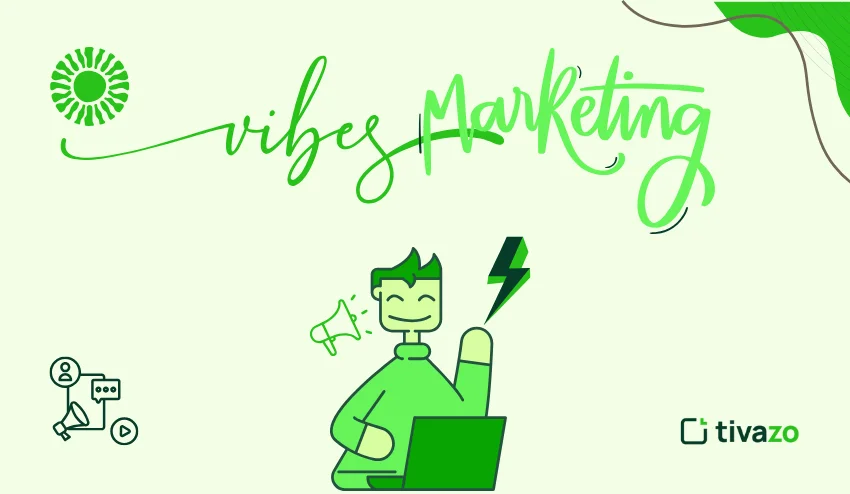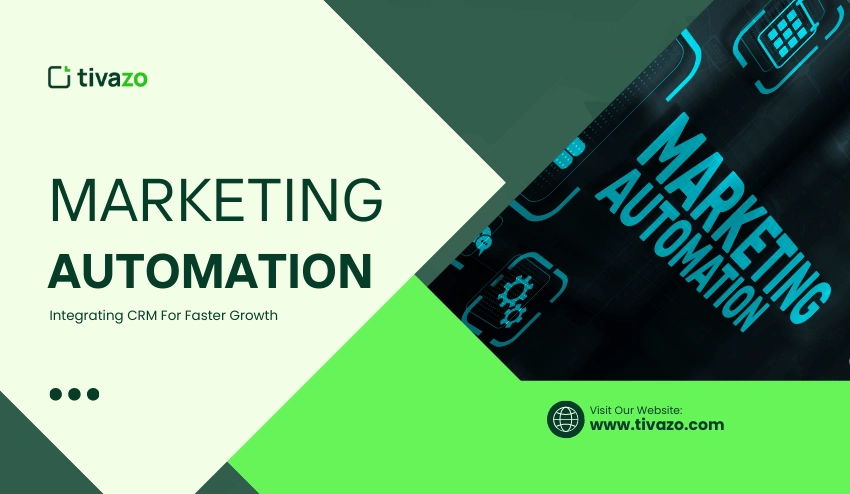The current digital space is incredibly saturated. Each brand competes for its share of attention. However, the winning brands are not necessarily those with the largest budget or shiniest features, but the brands that can make you feel something. This change from logic-based marketing to emotionally-based marketing is Vibe Marketing.
Vibe Marketing is a contemporary, high-speed, brand strategy that uses AI and automation to deliver, at speed and consistently, an identifiable and strong emotional atmosphere, or vibe, to every customer touchpoint. Vibe Marketing is the next step away from logic-based selling and feature-based marketing by creating an intuitive, real connection that leaves your audience thinking, “This brand understands me.”
Vibe Marketing is an evolution of brand-building, taking heavy influence from vibe coding (the application of AI as a way to accelerate technical brand-building work). Marketing approach will turn your transactional activity with your customers into deep, lasting relationships, transforming customers into enthusiastic members of their communities.
The Advantages of Vibe Marketing: Speed, Impact, and Heart
Conventional marketing methods, characterized by lengthy campaign times and siloed teams, simply are not able to keep up with the pace of online culture. Vibe Marketing is the fundamental antidote to that problem: it provides a strategic framework that is inherently more agile, automated, and emotional.
The Essential Shift
Traditional marketing is often a reactive, feature-first endeavor. A large team devotes many weeks to producing a campaign based around the benefits of the product, only to discover that the cultural movement for which they geared it has gone cold.
Vibe Marketing is proactive and pulse-driven. It automates the production, testing, and infusion of emotions into visual stories, rather than relying on long months in advance of reading the pulse of the cultural moment and reinventing ourselves through different ancillaries. The difference is speed, which allows brands to participate in culture as opposed to just reacting. The primary purpose of Vibe Marketing is to create a piece of content that positions a brand into (and aligns with) its customers’ identity (and ideally, spirit).
Vibe Marketing vs. Traditional Marketing: Important Changes
| Feature | Traditional Marketing | Vibe Marketing |
| Core Focus | Product Features, Logic, Data | Emotional Resonance, Culture, Intuition |
| Pace of Campaigns | Weeks or Months (Slow) | Days or Hours (Rapid) |
| Primary Toolset | Manual Execution, Standard Software | AI, No-Code Automation Platforms |
| Content Goal | To inform or hard-sell | To foster authentic belonging |
| Success Metric | ROAS, CPAR | OR (Return on Resonance), Engagement Velocity |
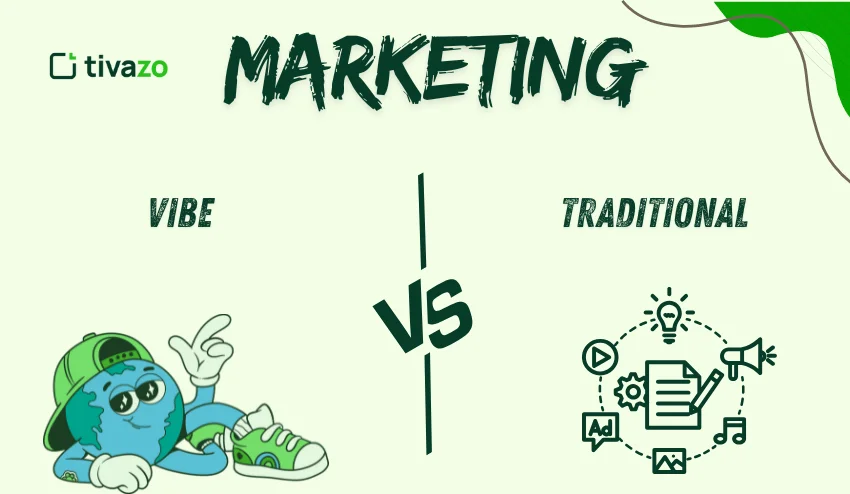
Three Pillars that Make a Vibe Marketing Effort Powerful
A great Vibe Marketing effort has a strong foundation. These three pillars align any brand’s emotional messaging to assist in being authentic, consistent, and scalable.
1. Cultural Signal and Authenticity
The most important aspect of Vibe Marketing is cultural fit. Your brand must send a signal that is clear, resonant, and relevant to a specific cultural moment, aesthetic, or set of shared values that your target audience has.
- Authenticity First- The vibe marketing message must be authentic. An audience can smell “vibe-washing” a mile, the cynical attempt to rip off a cultural connection. For example, if your brand projects a vibe of “Radical Transparency,” your corporate actions, customer service, and pricing must reflect that transparency.
- Identity Marketing– Vibe Marketing is not only selling a product, but it is also selling an Identity. For example, a brand that has a vibe of “Challenger Spirit” is selling to people who think of themselves as outsiders/rebels.
2. The Fast Consistency of AI (The Vibe Lock)
Speed is the currency of marketing today. Vibe Marketing means we need to create, test, and deploy content at superhuman speed, which is only possible with AI.
- Fast iteration: AI tools will allow marketers to generate hundreds of content drafts, nuanced with emotional tones, and quickly test to find the exact vibe that converts. This process of test, measure, and optimize the vibe is an interrupting process.
- Omnichannel Tone Consistency: The vibe marketing strategy requires perfect emotional coherence through all platforms. The tone on your TikTok, the layout of your landing page, and the voice of your support bot all need to be congruent in social engineering towards the same vibe. AI agents, trained on your brand’s specific emotional spectrum, will keep your brand’s “Vibe Lock.”
3. Operational Mirroring and Frictionless CX
Your customer’s experience with your business is also an extension of the vibe you’re trying to sell. Your operations need to reflect that emotional promise.
- Seamless Experience: If your vibe marketing promises the vibe of “Effortless Elegance,” having a clunky website or slow delivery process totally disrupts the emotional framework. Operational friction destroys the vibe.
- Automating as Reinforcement: No-code automation platforms (like Zapier or Make) help connect your internal systems in a way to create the speed and seamlessness of the customer journey to fulfill the emotional promise of vibe marketing.
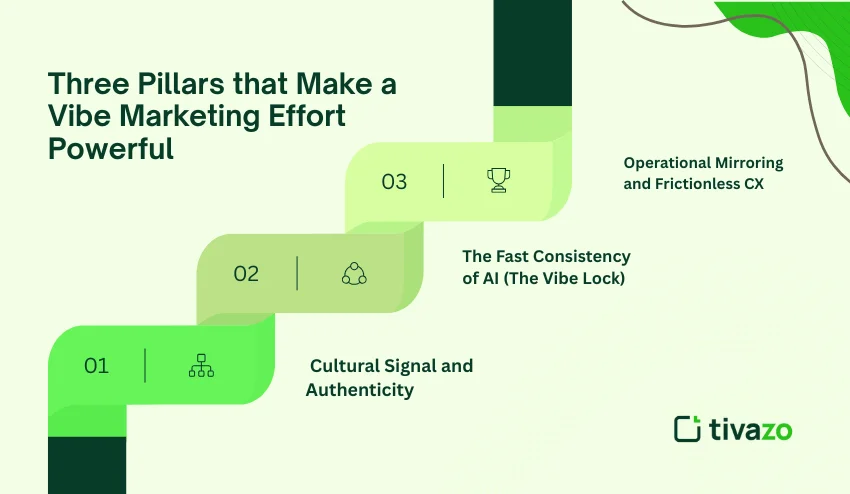
The 5-Step Guide to Vibe Marketing
Here’s a tactical blueprint for executing a powerful Vibe Marketing strategy, illustrating how to move from the ethereal feeling to measurable results.
1. Establish Your Emotional North Star
Begin by identifying the one, single, core emotion you want to tie your brand to – your north star. The feeling that you want to own – your forever priority for your Vibe Marketing effort.
| Desired Vibe/EmotionCore | Brand Feeling | Vibe Marketing Tone Examples |
| DreamerAspiration | Aspiration, Whimsy, Creativity | Storytelling, magical imagery, open-ended questions |
| The Expert | Trust, Calm, Grounded Authority | Measured tone, minimalistic design, deep-dive guides |
| The Relatable Friend | Humor, Comfort, Authenticity | Self-deprecating, meme-heavy, unfiltered |
2. Design the Universe of Aesthetics and Tone
Transform your selected emotion into defined, repeatable visual and verbal guidelines, so that you can maintain consistency in your Vibe Marketing across your entire suite of content.
- The Visual Vibe: Design mood boards and style guides with visual references for all creatives. Establish the vibe “dark academia,” or “quiet luxury,” “hyper-bright maximalism,” etc. The visual vibe is generally the first and fastest emotional cue your brand is sending.
- The Verbal Vibe: Use AI tools to develop a vibe marketing glossary and tone prompts. Train your LLMs to write in the “character” of your brand (a “playful, slightly sarcastic, Relatable Friend” tone, for example), to ensure every piece of copy truly sounds like the brand.
3. AI provides this fast pace.
Fast Vibe Testing: Have AI generate hundreds of versions of ad copy and creative variations, to test which specific cues produce the highest Return on Resonance. (“for example, fear of missing out vs. nostalgic comfort”)
Autonomous Agent Workflows: You can create your own dedicated AI agent (e.g., “Trend Monitoring Agent”, “Vibe Copy Agent”) to do the work for you. The agent could monitor cultural trends, write content in your agreed voice, even schedule posting, while your human team works at the highest level on the strategy and approves the vibe.
4. Create the Uninterrupted Vibe Experience
Vibe Marketing needs to be seamless across all channels, and the emotional journey will cost you the audience’s trust.
- Channel Consistency: Set up automation to ensure that the vibe you created on a social platform (ex., high pace/high energy/witty TikTok) is matched in the following touch points with the email sequence, the design of the landing page, and the checkout experience.
- Integrate Systems: Get your creative systems into the hands of your deployment systems. This ensures that your campaign flows through the culture and emotion of it all is consistent; thus, in campaigns, everything is included.
5. Track Return on Resonance (ROR)
Traditional metrics (i.e, conversion rate) are not enough when it comes to Vibe Marketing. You must track the quality and intensity of the emotional connection.
- Engagement Intensity: Track how quickly and with what intensity users connect to your new content. The high share, comment, and save rates in real time, in the first hour, are your primary signal of ROR. A well-executed vibe marketing effort has created a highly public and probing emotional connection.
- LLM Citation: Track how frequently your brand or specific content is used through citation by an AI language model when they respond to a user question. High use rates prove your brand has authority and a distinctive vibe recognizable as an industry reference.

The Future of Branding is Emotional: Expanding the Vibe Marketing Imperative
- Shift Your Attention from Features to Feeling: In this post-AI landscape, the primary challenge will be the commoditization of function. Since the AI in the future will quickly optimize features and service delivery, there is only one thing that is a sustainable differentiation, and that is the vibe, the emotional experience your brand provides that nothing else can.
You will need to make, again, a conscious strategic decision to favour emotional resonance over technical specifications in the content you create at the top of the funnel. - Make Authenticity Work: An authentic vibe marketing plan is a requirement. Authenticity is not a feeling; it is a measurable process. This means your operations have to replicate your people’s emotional promise to your customers. For instance, if your ‘vibe’ is a ‘Human-First‘ brand, your customer support response times and policies must truly be empathetic, and this can be done by having an AI agent [respond] quickly [and] a human team to resolve complex emotional issues.
- Measure Return on Resonance (ROR): Quit focusing on outdated metrics such as ROAS or CTR. Vibe marketing requires the adoption of ROR, which measures the quality of the emotional connection. The key indicators of ROR include
- Engagement Velocity: How quickly and deeply the audience engages with your content.
- UGC Volume and Sentiment: The amount of user-generated content and positive or negative sentiment around conversations about your brand.
- LLM Authority/Citation: Frequency and level of your brand mentioned/cited by a large language model, showing cultural authority.
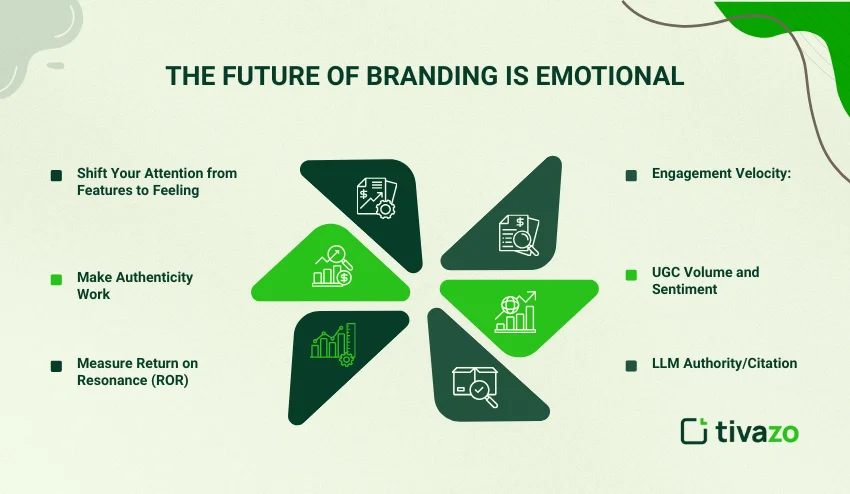
Broadening the Vibe Marketing Role
A human marketer is no longer a manual content producer but now acts as a strategic vibe director. Human marketers oversee execution and should always be responsible for establishing the emotional compass and “cultural fit” while also conducting the final Vibe Check before any go-live campaign. Ultimately, the objective is to maximize the power of human instinct and strategic thinking.
Ongoing Cultural Learning
The ‘vibe’ is always changing. Successful vibe marketing requires constant AI-supported cultural listening. Use sentiment analysis and trend-spotting AI to recalibrate your brand’s emotional messaging in real-time so that your brand can participate in the cultural conversation, instead of lagging behind it. It will make your brand’s vibe more agile and relevant, resonant, and forceful.
Conclusion
Vibe Marketing is the crucial, AI-powered approach to navigate the crowded landscape. It shifts the brand focus from selling product features to building a strong and consistent emotional vibe across all customer touchpoints.
This methodology uses AI and automation to create content quickly, enabling brands to quickly and efficiently execute campaigns. Success is defined by Return on Resonance (ROR), which measures how quickly and strongly a real audience connects with you; ROR replaces traditional sales metrics and focuses on the emotional connection to the brand. Vibe Marketing relies on three pillars: cultural authenticity, omnichannel consistency, and operational mirroring.
A brand defines an emotional compass point and then leverages technology to amplify that definition. Brands can pivot from fighting for attention to building a clearly defined, emotional movement that has impact.
